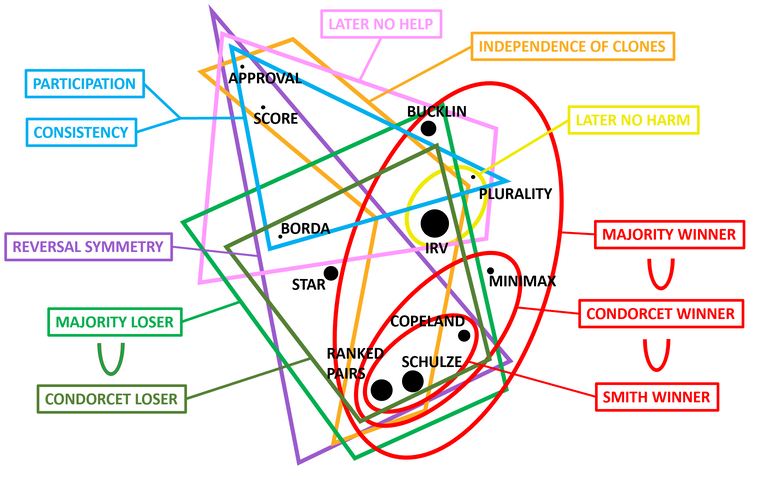Pairwise Matrix / Preference / Ranked Pairs / Cardinal pairwise
-
How to learn this lingo:
Pairwise Matrix
Pairwise preference
Pairwise preference - Strength of preference and rated pairwise preference ballot.
Ranked Pairs
Score Sorted Margins
Smith set vs Copeland set vs Schwartz set
Approval Sorted Margins
Pairwise Winner
Ranked Winners
Condorcet Winner (CW) / Loser (CL) / Improved Condorcet winner / Weak Condorcet loser
Improved Condorcet winner
Smith set vs Copeland set
Cardinal pairwise, cardinal-weighted pairwise (CWP) comparison -
-
@toby-pereira Is there a difference in an approach between Scoring (Cardinal/Rating) and Rankings (Ordinal) with equal ranks ?
Obviously the direction must be flipped
- score - high numbers (4,5) - winners,
- rankings - low numbers winners (1,2,3)
-
@masiarek I am not @Toby-Pereira but the difference really is a matter of the difference between ordinals and cardinals. Cardinals are ordinals with an enriched structure, since in addition to ordering they have some sort of “difference magnitude” structure. One can generalize rank-order and scoring to a common structure which is an “ordinal scoring” system.
A while back I tried writing a bit about this (the style is more politically charged than I would write today, I can only admit that I was and am and probably always will be a half-insane person): https://drive.google.com/file/d/12FIZh6h65YB0u-Y3fxf69kGhnHpaa6FF/view?usp=sharing
It’s only food for thought, lots of your questions seem similar to what I wanted to understand when I first joined this forum. We have a lot of past discussions about the Condorcet criterion as well, you can search them up and read them to get some ideas!Ultimately most of my explorations in alternatives have proved mostly fruitless against rational arguments made by other forum users. Today my thinking is that Condorcet methods and proportional representation (PR) are probably the way to go, even though both have problems. You can get a feel for what certain users think according to their little tags (which we have as 0-10 cardinal ballots of different types of single-winner voting systems).
Here is a little (somewhat complicated) “3-d mind map” of some good voting systems you might be interested to learn about:

(And if I recall correctly, everything “below” IRV is monotone as well. Something I would like is to have a table of the voting theoretical criteria and indications of logical compatibility. This isn’t important in practice per se since methods can fail a criterion in absolute terms but still conform to results that fit with the criterion “often enough.”)
My thinking in this area nowadays is related to methods to select a proxy for the Condorcet winner when one does not exist, and how to mitigate majoritarianism and block formation in PR.
-
@cfrank said in Pairwise Matrix / Preference / Ranked Pairs / Cardinal pairwise:
Cardinals are ordinals with an enriched structure, since in addition to ordering they have some sort of “difference magnitude” structure.
This is the answer. You can rank three candidates 1, 2, 3 but give them scores (out of 10) of 10, 1, 0. So that tells you more than just your ranking.
Obviously in real life elections, there's debate about the meaning of the scores and whether they're just used as a strategical device rather than a genuine measure of preference difference, but that's for another day.